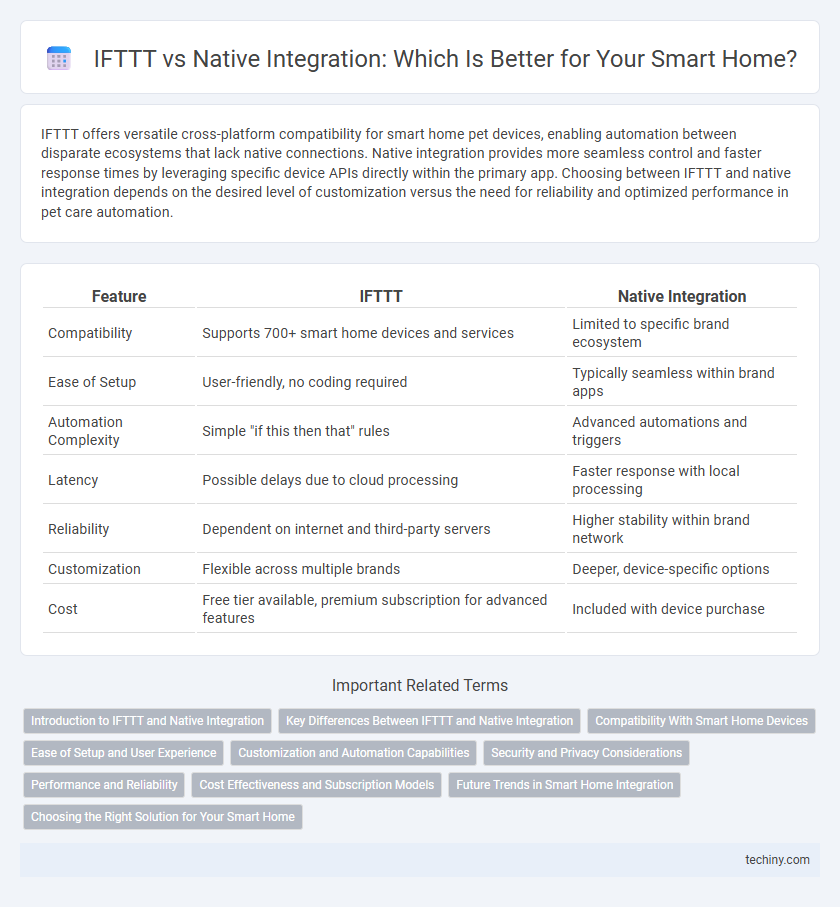IFTTT offers versatile cross-platform compatibility for smart home pet devices, enabling automation between disparate ecosystems that lack native connections. Native integration provides more seamless control and faster response times by leveraging specific device APIs directly within the primary app. Choosing between IFTTT and native integration depends on the desired level of customization versus the need for reliability and optimized performance in pet care automation.
Table of Comparison
| Feature | IFTTT | Native Integration |
|---|---|---|
| Compatibility | Supports 700+ smart home devices and services | Limited to specific brand ecosystem |
| Ease of Setup | User-friendly, no coding required | Typically seamless within brand apps |
| Automation Complexity | Simple "if this then that" rules | Advanced automations and triggers |
| Latency | Possible delays due to cloud processing | Faster response with local processing |
| Reliability | Dependent on internet and third-party servers | Higher stability within brand network |
| Customization | Flexible across multiple brands | Deeper, device-specific options |
| Cost | Free tier available, premium subscription for advanced features | Included with device purchase |
Introduction to IFTTT and Native Integration
IFTTT (If This Then That) enables smart home devices and apps from different brands to work together seamlessly through customizable applets, enhancing automation without requiring native compatibility. Native integration refers to the built-in ability of smart devices to communicate directly within a single ecosystem, offering faster response times and more reliable performance. Choosing between IFTTT and native integration depends on the desired flexibility versus seamlessness in smart home automation.
Key Differences Between IFTTT and Native Integration
IFTTT enables cross-brand smart home automation by connecting disparate devices through cloud-based applets, while native integration offers direct device-to-device communication within a specific ecosystem, ensuring faster response and improved reliability. IFTTT supports a broad range of third-party services, providing extensive flexibility at the cost of potential latency and security concerns, whereas native integration benefits from optimized performance and deeper feature access tailored to the manufacturer's hardware and software. Choosing between IFTTT and native integration depends on the desired balance between interoperability, speed, and control within a smart home environment.
Compatibility With Smart Home Devices
IFTTT supports a vast range of smart home devices from multiple brands, providing extensive compatibility and enabling cross-platform automation. Native integration ensures seamless operation and optimized performance within specific ecosystems like Apple HomeKit, Google Home, or Amazon Alexa. Choosing between IFTTT and native integration depends on whether broad device compatibility or deep system integration is the priority for the smart home setup.
Ease of Setup and User Experience
Native integration in smart home devices offers seamless setup and intuitive user experience by directly connecting compatible products within a single ecosystem, reducing the need for multiple apps or complex configurations. IFTTT provides broader compatibility across diverse brands but often requires manual applet creation, which can be less intuitive and time-consuming for users unfamiliar with automation platforms. For consumers prioritizing ease of use and streamlined control, native integrations typically deliver a more polished and hassle-free smart home experience.
Customization and Automation Capabilities
IFTTT offers extensive customization and flexible automation capabilities by enabling users to create complex multi-device workflows across numerous platforms, surpassing many native integrations limited to single-brand ecosystems. Native integrations provide faster, more reliable automation with direct device communication, but often lack the granular control and cross-platform versatility that IFTTT's applets facilitate. For users seeking comprehensive smart home automation involving diverse brands and personalized triggers, IFTTT delivers superior customization options compared to the usually simpler native solutions.
Security and Privacy Considerations
Native integration in smart home systems offers enhanced security by minimizing reliance on third-party platforms, thereby reducing potential data exposure. IFTTT, while providing versatile automation across multiple devices and services, introduces additional data transmission points that may increase privacy risks. Prioritizing native integration can ensure tighter control over data encryption and user permissions, beneficial for safeguarding sensitive home information.
Performance and Reliability
Native integration in smart home devices typically offers superior performance and reliability due to direct communication protocols and optimized firmware. IFTTT relies on cloud-based services and internet connectivity, which can introduce latency and occasional failures. Devices with native integration provide faster response times and more consistent operation, ensuring a seamless smart home experience.
Cost Effectiveness and Subscription Models
IFTTT offers cost-effective automation by enabling free and low-cost applet creation across multiple smart home devices, reducing the need for multiple subscriptions. Native integration often requires purchasing premium subscriptions or proprietary hubs, leading to higher long-term costs but providing deeper device compatibility and reliability. Choosing IFTTT minimizes upfront expenses and supports diverse ecosystems, while native integration may increase costs due to exclusive features and vendor lock-in.
Future Trends in Smart Home Integration
Future trends in smart home integration emphasize seamless interoperability between devices through both IFTTT and native integration platforms. While IFTTT offers flexibility by connecting diverse smart devices across brands, native integrations provide deep, optimized functionality with enhanced security and faster response times. Advancements in AI-driven automation and edge computing are expected to bridge these methods, delivering more intuitive and personalized smart home experiences.
Choosing the Right Solution for Your Smart Home
Choosing the right solution for your smart home depends on the level of customization and device compatibility you need. IFTTT offers extensive cross-brand automation by connecting disparate smart devices through user-created applets, ideal for a highly adaptable ecosystem. Native integration provides faster, more reliable communication by leveraging built-in support within a smart home platform such as Amazon Alexa, Google Assistant, or Apple HomeKit, ensuring seamless device control and enhanced security.
IFTTT vs Native Integration Infographic

 techiny.com
techiny.com